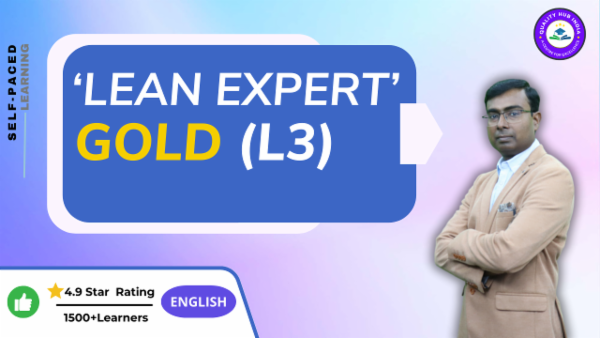There are no items in your cart
Add More
Add More
| Item Details | Price | ||
|---|---|---|---|
Globally recognized and accredited Online Training and Certification course on Certified 'Lean Expert - Gold Level' - Level 3
5.0 (744 ratings)
Language: English
Instructors: Dr. Aryan Viswakarma
Validity Period: 1095 days
Why this course?
Course: Lean Expert Gold Level - 3
Course Duration: 26 hrs
Course Objectives
The Lean Expert Gold Level course takes the advanced elements learned in Lean Silver a step further by developing your capability in both the application of advanced Lean tools and in facilitating business-wide lean programs of improvement.
After this course you will:
Prerequisites
At least 3 years of Industry experience with basic conceptual knowledge of Lean Concept or have certified to QHI Lean Expert Silver Level course.
Who Should Attend?
Join Our Weekly Live Doubt-Clearing Sessions
We are committed to your learning success! To ensure clarity and help you achieve your goals, we conduct live doubt-clearing sessions every week.
Why Attend?
Certification Exam Guidelines
Examination Format:
Course Validity & Exam Timeline:
Note: Attempting the exam after the one-year period will require an additional fee.
Certification:
Sample Certificate:
Policy on Cancellation and Refunds
For Technical Support-
Contact us at +91- 7988293436 or drop a mail at care@qualityhubindia.com
*Prices may change at any time without prior notice.
REQUEST FOR COURSE VALIDITY EXTENSION
You can also pay by scanning a QR code. Kindly share a screenshot by mail at care@qualityhubindia.com with full details after payment (Name, Email id, Contact No. and Course Name)

Benefits of Doing Courses from Quality HUB India™
Awards & Recognitions
Accreditations & Certifications

· Introduction to Lean MFG
· Ford Mass Manufacturing and Toyota Production System
· World Class Manufacturing system
· Science of Lean Manufacturing – Introduction
· What is Process? and Lean Manufacturing details
· Why to implement Lean Manufacturing? and Purpose of Lean Manufacturing
· Lean Model Components and Tools
Introduction to Top 20 Lean Tools
5S -Work Place Management System
Kaizen- Continual Improvement System
Concept of 3M – MUDA, MURA and MURI
Kaizen Job Function
Single Minute Exchange of Dies (SMED)
· Intro, Benefits, and Types of Waste
· Action to reduce setup time
· 04 Stages of Improvement
· Improvement Example
· Common Problem and Solutions
· Manifold and Cart Example
Mistake Proofing or POKAYOKE
· What is Mistake-Proofing?
· Category of Poka-yoke
· Poka-yoke Examples -General and Industrial
Andon System
· What is Andon System
· History and Benefits of the Andon System
· Types of Andon
Visual Management
· Introduction and Background of Visual Management
· Why Visual Management
· Purpose of Visual Management
· Visual Management- Types and Examples
· Colour Coding Visuals and Why Visual Management Fails?
Value Stream Mapping (VSM)
· Introduction to VSM and Perfect Process
· How to maximize value & customer demand?
· Why & How to use VSM
· VSM Steps and Process Cycle Efficiency (PCE)
· Analyzing the VSM and Projects
Just in Time (JIT) System
· Definition and Main Elements of JIT
· The Problem Manufacturing
· JIT Case Study- Process Steps
· JIT Implementation
· JIT Background
Time Study Analysis
· Time Study Analysis and Purpose of Time Study
· Time Study Analysis
· How to do Time study, Formats, and Basic Principles
· Basic Principles of Ergonomics
Standardized Work
· Standardized Work-Role of a Leader
· Standardized Work- Cost Reduction Principle, Trends
· Standardized Work- TPS Pillar Chart
· Benefits & Subjects for Standardization
· Standardized Work-Important Formats
· Work Elements & Analysis for Standardized Work
· Ideal conditions for Standardized Work
· Standardized Work (Process Capacity Sheet)
· Standardized Work Chart
· Methods to Increase Production, Types of Waste etc.
Single Piece Flow (SPF)
· Single Piece Flow in Lean Manufacturing
· Single Piece Flow in Lean Manufacturing- One Piece Production: Comparison
· Single Piece Flow in Lean Manufacturing-Batch Production Vs Flow Processing
Total Productive Maintenance (TPM)
· Introduction and Benefits of TPM
· TPM Pillars
· TPM Implementation Plan and Steps
· TPM Implementation Steps (Elaboration)
Toyota Production System (TPS)
· TPS Structure
· History of Toyota
Overall Equipment Effectiveness (OEE)
· Introduction to OEE and requirement of QMS
· OEE 3 critical factors
· OEE - Critical Factors Formula
· OEE- Calculating Losses
· OEE Calculation Samples
· OEE Improvement and Display
· What is loss and 6 types of key losses in OEE
· Major Losses Impacting OEE
'KANBAN' Management System
· KANBAN
· kanban Type and How they work
· Kanban-Visual Management
· How kanban works & 3 Types of Withdrawal Kanban
· Customer kanban card signal Flow
· Move Kanban Card
· Production Kanban
· Flow of Kanban Signal
· Steps to implement Kanban
Milk Run Concept
· Milk Run-Intro, History, and Procedure
· Difference between Milk Run and Kanban
· Examples of Milk Run Implementation
Heijunka - Line Balancing
· Introduction to Heijunka
· Heijunka in Toyota Production System
· Heijunka- 03 Tools to Prevent Overproduction
· Why implement Heijunka?
· Steps for Implementation Heijunka
Line Design (Product Handling Ideas)
Theory of Constraints (TOC) (Drum-Buffer-Rope Technique)
Gemba Walk Process
· Intro and Key concept in Gemba Walk
· 8 Steps in Gemba Walk
· What to look for during Gemba Walk?
· Tools to be used and questions-Gemba Walk
Cycle Time Reduction Method
· Cycle Time Reduction- Intro and Its Importance
· Common Methods for Cycle Time Reduction
· Case Study-Cycle Time Reduction
Obeya System
· Basics of Obeya and Toyota Management System
· Obeya- Toyota Management System Tools
· Obeya- Role of Managers
· Obeya Big Project Room Layout
· Obeya Leader and Member Role
Stop the Line Concept
· Stop the line Concept- Introduction
· Stop the Line Concept Benefits
7 Basic Quality Control Tools
· Introduction to Problem-Solving Tools and Cause-Effect Diagram
· Flow Chart
· Histogram
· Pareto Diagram or Pareto Chart
· Control Chart
· Scatter Plot
Important Concept and Support Lean Tools
· JIDOKA or Autonomation- How it Works?
· Value Added(VA) and Non-Value Added (NVA) Analysis
· TAKT Time VS Cycle Time VS Lead Time VS Throughput Time – Difference explained with example
· 3K Technique -Importance of Standardization
· Toyota Way– ‘The 14 Principles of the Toyota Way’
· 5G Technique of Problem Solving
Lean Implementation Steps
· Roadmap for Lean Implementation
· Lean Implementation Steps
Employee Motivation and Relevant Theory
· Motivational Technique and Fredrick Taylor Concept
· Hawthorne Study
· Maslow's Law of Hierarchy
· Mc Gregor Theory X and Theory Y
Lean Case Studies
Additional Resources
After successful purchase, this item would be added to your courses.You can access your courses in the following ways :
